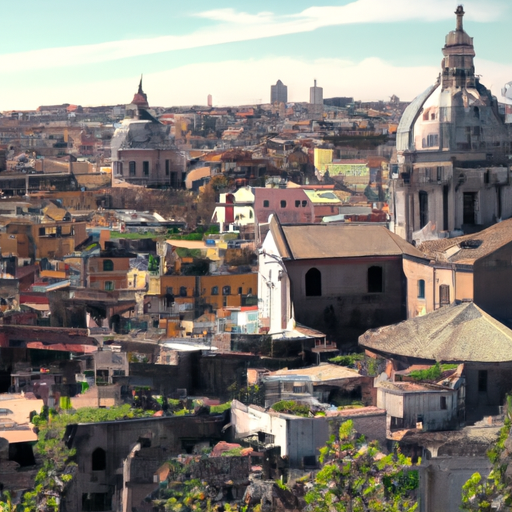
Key Factors Driving Italy’s Travel & Tourism Sector Recovery
Italy’s Travel & Tourism sector has experienced a strong recovery, according to a recent report by the World Travel & Tourism Council (WTTC). This is great news for the country, which has been heavily impacted by the COVID-19 pandemic. In this article, we will explore the key factors that have contributed to this recovery.
One of the main factors driving the recovery of Italy’s Travel & Tourism sector is the successful vaccination campaign. Italy has made significant progress in vaccinating its population, which has helped to boost confidence among travelers. With more people getting vaccinated, there is a reduced risk of contracting and spreading the virus, making it safer to travel.
Another important factor is the easing of travel restrictions. Italy has gradually lifted many of the restrictions that were put in place to control the spread of the virus. This has allowed both domestic and international travelers to visit the country more freely. The reopening of borders and the resumption of international flights have also played a crucial role in attracting tourists back to Italy.
Furthermore, the implementation of health and safety protocols has been instrumental in rebuilding trust in the Travel & Tourism sector. Italy has implemented strict measures to ensure the safety of travelers, such as mandatory mask-wearing, social distancing, and enhanced cleaning and sanitization procedures. These measures have reassured tourists that their health and well-being are a top priority, making them more comfortable with the idea of traveling to Italy.
The digitalization of the Travel & Tourism sector has also played a significant role in the recovery. Italy has embraced technology to adapt to the new normal. Online booking platforms, contactless payments, and digital health passports have made it easier for travelers to plan and enjoy their trips. This digital transformation has not only improved the overall travel experience but has also helped to minimize physical contact and reduce the risk of virus transmission.
Additionally, the government’s support and incentives have been crucial in reviving the Travel & Tourism sector. Italy has implemented various measures to support businesses in the sector, such as financial aid, tax relief, and grants. These initiatives have helped businesses stay afloat during the crisis and have encouraged them to invest in the necessary safety measures to attract tourists.
Lastly, the natural beauty and cultural heritage of Italy have always been a major draw for travelers. Despite the challenges posed by the pandemic, Italy’s iconic landmarks, picturesque landscapes, and world-renowned cuisine continue to attract tourists from around the globe. The country’s rich history and vibrant culture make it a unique and enticing destination, and this allure has played a significant role in the recovery of the Travel & Tourism sector.
In conclusion, Italy’s Travel & Tourism sector has made a strong recovery, thanks to several key factors. The successful vaccination campaign, the easing of travel restrictions, the implementation of health and safety protocols, the digitalization of the sector, government support, and Italy’s inherent charm have all contributed to this recovery. As the sector continues to rebound, Italy is once again becoming a top destination for travelers seeking unforgettable experiences.
Impacts of WTTC’s Report on Italy’s Travel & Tourism Industry

Italy’s Travel & Tourism sector has experienced a strong recovery, according to a recent report by the World Travel & Tourism Council (WTTC). This report highlights the positive impacts that the sector has had on the country’s economy and the potential for further growth in the future.
The WTTC report reveals that Italy’s Travel & Tourism sector contributed a staggering €232.2 billion to the country’s GDP in 2019, accounting for 13.1% of the total. This demonstrates the significant role that the industry plays in Italy’s economy, providing jobs and generating revenue. The report also indicates that the sector supported over 4.2 million jobs in 2019, which is equivalent to 15.3% of total employment in the country.
The COVID-19 pandemic had a severe impact on the global Travel & Tourism industry, and Italy was no exception. However, the WTTC report shows that the sector is bouncing back, with a projected growth rate of 5.8% per year over the next decade. This is great news for Italy, as it indicates that the industry has the potential to regain its pre-pandemic strength and continue to contribute significantly to the country’s economy.
One of the key factors driving the recovery of Italy’s Travel & Tourism sector is the country’s rich cultural heritage and historical attractions. Italy is renowned for its iconic landmarks such as the Colosseum, the Leaning Tower of Pisa, and the Vatican City. These attractions have always been a major draw for tourists from around the world, and their reopening after the pandemic has sparked renewed interest in visiting Italy.
Furthermore, Italy’s natural beauty, including its stunning coastlines, picturesque countryside, and world-famous lakes, continues to attract travelers seeking relaxation and outdoor activities. The country’s diverse landscapes offer a wide range of experiences, from hiking in the Dolomites to sunbathing on the Amalfi Coast. This natural beauty, combined with Italy’s rich cultural heritage, makes it a top destination for travelers.
The WTTC report also highlights the importance of sustainable tourism in Italy’s Travel & Tourism sector. The report states that the industry has made significant progress in adopting sustainable practices, such as reducing carbon emissions and promoting responsible tourism. This commitment to sustainability not only benefits the environment but also enhances the overall visitor experience, as travelers increasingly seek out destinations that prioritize environmental and social responsibility.
In conclusion, the WTTC’s report on Italy’s Travel & Tourism sector reveals a strong recovery and promising future for the industry. The sector’s contribution to Italy’s economy is significant, providing jobs and generating revenue. The country’s rich cultural heritage, natural beauty, and commitment to sustainability are key factors driving the recovery and attracting travelers. With a projected growth rate of 5.8% per year, Italy’s Travel & Tourism sector is poised to regain its pre-pandemic strength and continue to thrive in the years to come.
Future Growth Opportunities for Italy’s Travel & Tourism Sector
Italy’s Travel & Tourism sector has experienced a strong recovery, according to a recent report by the World Travel & Tourism Council (WTTC). This is great news for the country, as it indicates that there are promising future growth opportunities for the sector.
One of the key factors contributing to this recovery is the increasing number of international tourists visiting Italy. The report highlights that Italy welcomed over 62 million international visitors in 2019, a significant increase from previous years. This surge in tourism can be attributed to various factors, such as the country’s rich cultural heritage, stunning landscapes, and world-renowned cuisine.
Furthermore, the report suggests that Italy’s Travel & Tourism sector has the potential to further grow in the coming years. This is due to the country’s diverse range of attractions and activities that cater to different types of travelers. From historical sites like the Colosseum and the Vatican City to picturesque coastal towns like Amalfi and Cinque Terre, Italy offers something for everyone.
In addition to its natural and cultural attractions, Italy is also known for its luxury and high-end tourism offerings. The report highlights that luxury travel is a growing segment in the country, with an increasing number of affluent travelers seeking exclusive experiences. This presents a significant opportunity for Italy to further develop its luxury tourism sector and attract high-spending visitors.
Another area of potential growth for Italy’s Travel & Tourism sector is sustainable tourism. The report emphasizes the importance of sustainable practices in the industry, as travelers are becoming more conscious of their environmental impact. Italy has already taken steps towards sustainable tourism, with initiatives such as eco-friendly accommodations and responsible tour operators. By further promoting and investing in sustainable practices, Italy can position itself as a leading destination for eco-conscious travelers.
Furthermore, the report highlights the importance of digital innovation in driving future growth for Italy’s Travel & Tourism sector. With the rise of technology and online platforms, travelers are increasingly relying on digital tools to plan and book their trips. Italy has the opportunity to leverage this trend by investing in digital infrastructure and offering innovative online services to enhance the travel experience.
Moreover, the report suggests that Italy should focus on diversifying its source markets to ensure a sustainable growth trajectory. While traditional markets like Europe and North America continue to be important, there is potential to tap into emerging markets such as China and India. By targeting these markets and tailoring their offerings to meet the specific needs and preferences of these travelers, Italy can attract a new wave of visitors and further boost its Travel & Tourism sector.
In conclusion, the WTTC report highlights the strong recovery of Italy’s Travel & Tourism sector and the promising future growth opportunities it presents. With its diverse range of attractions, luxury offerings, sustainable practices, digital innovation, and potential in emerging markets, Italy is well-positioned to continue attracting international visitors and further develop its tourism industry. As travelers seek unique experiences and sustainable options, Italy has the chance to showcase its rich cultural heritage, breathtaking landscapes, and world-class hospitality to a global audience.


